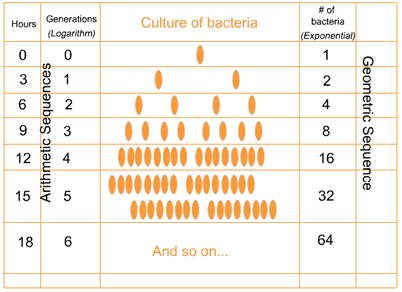Logarithmic functions in the biological sciences
Now, we will return to our example of a culture of bacteria that reproduces
by binary fission every three hours.

In the exponential section we
posed the following questions about this bacterial culture,
- How many bacteria will be present
after 51 hours if you inoculate a culture with 1 bacterium?
- How
many bacteria should you
inoculate a culture with if there are to be 81,920 bacteria present
after 42 hours?
Now what if we pose a third question
- How long would it take for an initial population of
six to reach a size of 12,288 bacteria?
To answer this question , you need to solve for an unknown
time. How would you isolate the variable t when it is
part of the exponential. To do this you need to understand
logarithms and logarithmic functions.
Logarithmic and exponential functions are inverse
functions
Logarithmic functions arise naturally after the study of exponential
functions. Mathematically speaking, logarithmic functions and exponential
functions are inverses of one another. Practically speaking, logarithms
are needed to solve problems involving exponentials and vice versa.
In a sense, logarithmic functions “undo” exponential functions, and exponential functions "undo" logarithmic functions.
We will
use this fact to solve equations that arise in various applications.
Before we get to these applications, we will develop some mathematics
behind the logarithmic functions,
as we did for exponential functions.
*****
